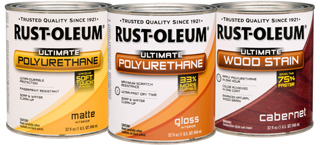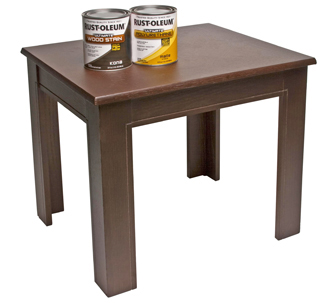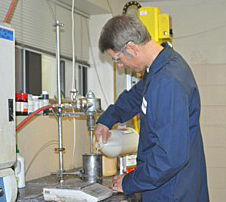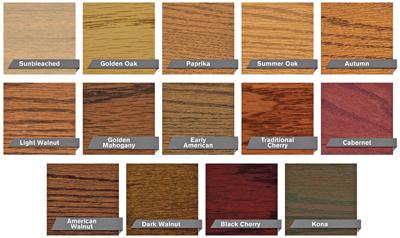
What wood finish do you typically use?
If it’s polyurethane, you probably choose it for its durability and versatility over a wide range of project applications. But while traditional oil-based poly is a shop favorite, it has several drawbacks: it has a strong solvent odor when curing, it can be a hassle to clean up and — one you might not have considered — it’s petroleum-based. Even the water-based polys that have been around for years have a petroleum source. The acrylics they contain are made of synthetic monomers derived from petroleum. So, despite their virtues, typical polyurethanes aren’t the “greenest” finishes on the shelf.
Rust-Oleum is making inroads to change polyurethane’s “petro pedigree” with its new line of Wood Care Ultimate polyurethanes and spar varnish. These finishes contain about 50 percent less petroleum content, because it’s replaced by a soybean-based polyurethane resin and soy-based acrylic. That formulation makes these products almost odor-free while offering soap-and-water cleanup. But moving away from petroleum doesn’t make them any less durable; in fact, the opposite seems true. According to company literature, Rust-Oleum’s new Ultimate Polyurethane provides 33 percent more durability than the leading competitive polyurethane, based on independent lab testing.
“We’ve always been on the cutting edge of wood finishes with our Varathane® brand. We developed the first oil-based poly in the 1950s, as well as the first water-based poly and gel stain,” says Lisa Skrdlant, Rust-Oleum’s Wood Care brand director. “We’ve been researching soy technology for over a decade now. We see where VOC restrictions are headed, and we are trying to get ahead of that with greener wood finish alternatives. Our new soy-based polyurethane and soy-based acrylic are industry firsts.”
John Schierlmann, technology manager for Rust-Oleum Zinsser Wood Care, explained the company’s soybean development this way. About 20 percent of soybean byproduct is soybean oil, used for both cooking oil and as the building block for an expanding variety of industrial products. “What we’ve done here is taken soybean oil and created a polymer with it that is more reactive and soluble in water. And, our soy acrylic uses an intermediate to replace about half of the petroleum monomer.”
Along with the new water-based topcoat options, Rust-Oleum also offers a new line of Ultimate interior wood stains in 14 shades. They benefit from soybean oil derivatives as well but are not water-based.
Lisa and John outlined a number of end-user advantages to these new stains and topcoats. They say the soy content actually mimics a traditional oil-based alkyd varnish or poly in a couple of ways: it imparts warm wood tones and has what John calls a “buttery feel” to it when brushed or sprayed. Lisa says the stains have better clarity and richness of color, because soybean oil replaces the linseed oil typically found in oil-based stains. It’s the ambering effect of linseed oil that can impart a murkiness to the stain color. She also pointed out that new stains are formulated to deliver correct color on the wood in one coat. “It will take less product to achieve your desired result, and our stains both color and seal the wood; you won’t need to use additional wood conditioner.”
“We hope that our new Wood Care products will also help change a mindset for woodworkers. Water-based technology has really improved over the years. Our polyurethanes and spar varnish offer the same or better durability as other products, with improved color and easy cleanup. There isn’t a compromise anymore to using a water-based finish,” Skrdlant says.
Another important offshoot of developing the soy-based Wood Care line goes right back to the farm fields: it encourages farmers to grow soybeans and supports the economic growth of the soybean industry. John says soybean farming is continuing to become more efficient, and crop yields are increasing. Soybean technology is developing a myriad of uses for this surplus, and the federal government is actively funding it. Lisa added, “We’ve received several grants from the USDA over the years to support our research. As they’ve seen the growth potential of the soybean market, they’ve continued to help further our efforts.”
Both John and Lisa see greater potential for soy-based woodworking products in the future. Stain and poly aren’t the end of the road here, and Rust-Oleum has more products in the works. John hopes other manufacturers will follow suit with “greener” finishing solutions. “We haven’t just stuck our toes in the water of this technology; we’ve jumped in wholeheartedly. Maybe our efforts will help push the consumer resin market to adopt more of a bio-basis in their products, too.”













